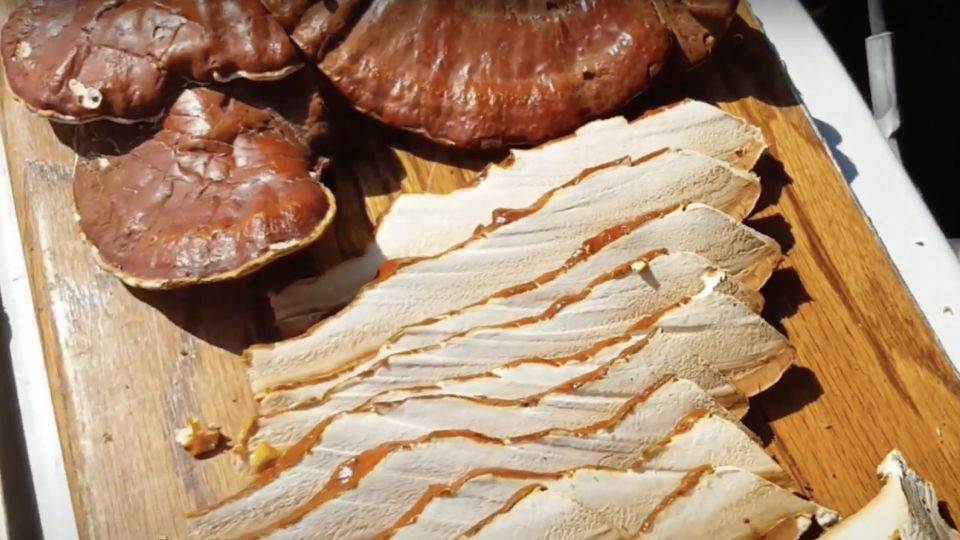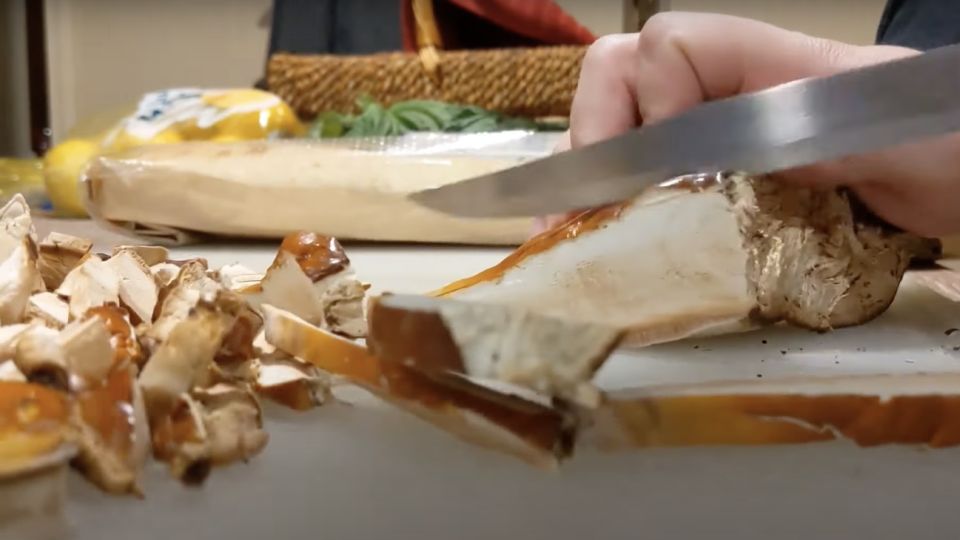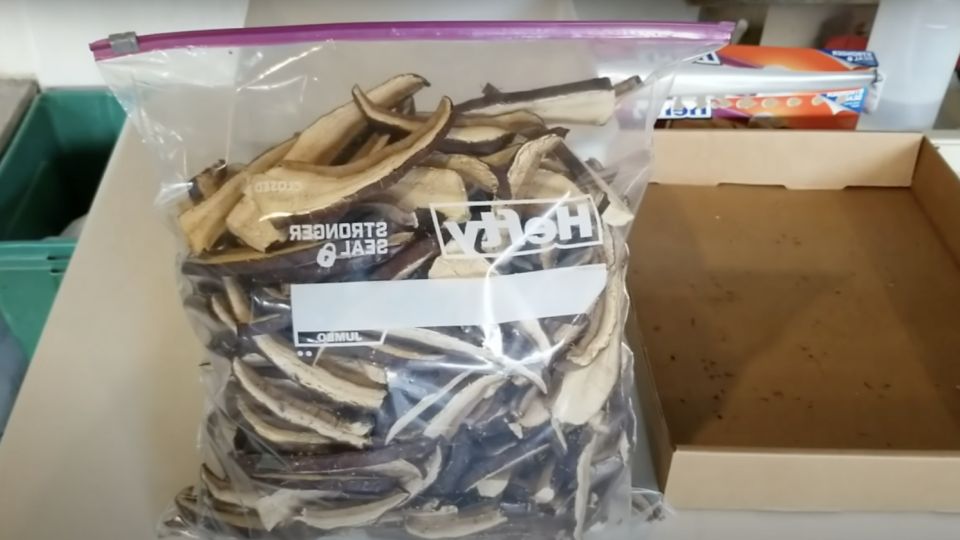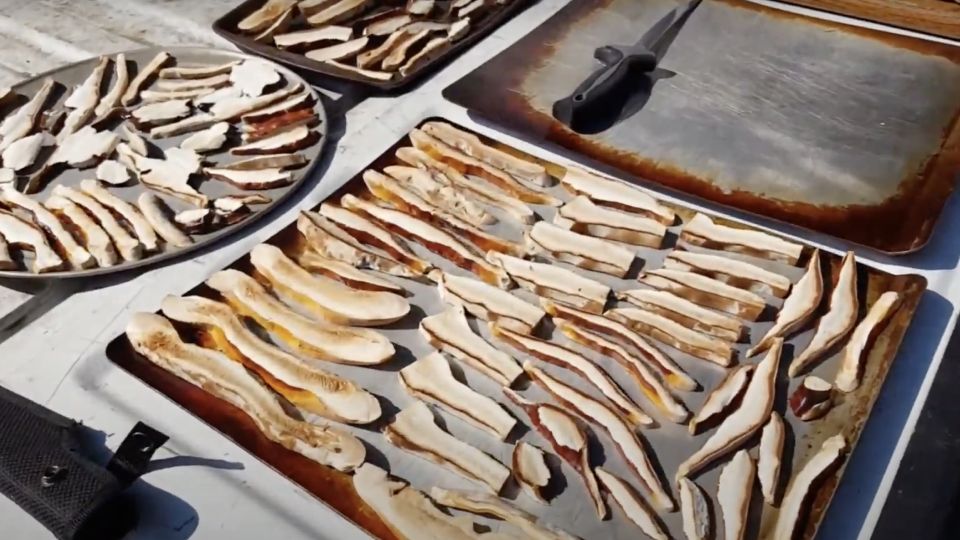How to Dry Reishi Mushroom (3 Ways)
If you’re a forager lucky enough to stumble upon some Reishi mushrooms, it’s essential to note that they’re a bit different from your typical mushrooms. Reishi mushrooms have a tough, woody texture, which means you can’t cook them up like regular mushrooms. The magic of Reishi lies in its extracts, which you can obtain through teas and tinctures.
Reishi grows slowly in the wild, so we encourage you to buy ethically grown Reishi. Or you can even try growing it yourself. Fresh Reishi doesn’t have a long shelf life, given its woody nature, so drying it is the most common preservation method. This not only extends its lifespan but also allows you to brew tea from it in the future.
But how to dry your fresh Reishi mushroom at home? In this post, we’ll take you on a journey through the intricacies of preparing, drying, and utilizing them.
In this article:
Prepare Reishi Mushrooms Before Drying
Before we get into learning how to dry a reishi mushroom, it’s vital to prepare them correctly. Start by cleaning them thoroughly to remove any dirt or impurities. Here’s a step-by-step guide:
- Gather Your Reishi Mushrooms.
- Examine the mushrooms for any visible dirt, debris, or insect remnants. Use a soft brush or cloth to gently remove these impurities.
- Give the mushrooms a gentle rinse under cold running water. Avoid soaking them, as reishi mushrooms are water-absorbent and could lose some of their potent compounds.
- After rinsing, pat the mushrooms dry with a clean towel or paper towel. Make sure they are entirely moisture-free before proceeding to the drying phase.
- Slice the mushrooms into 1cm thick pieces. This will speed up and improve the drying process for you. You can use a knife, or if you have one, a meat slicer for easier cutting.
How to Dry Reishi Mushroom – 3 Methods

Now that your reishi mushrooms are prepared and ready, it’s time to dive into the different drying methods available. There are three general methods. Each method has its advantages and disadvantages, catering to various preferences and needs.
1. How To Dry Reishi Mushroom With Air
Air-drying is the most natural method, ideal for those who want to preserve the full flavor and medicinal properties of reishi mushrooms.
Steps for Air-Drying:
- Place the slices on a clean, dry surface like a baking sheet or wire rack.
- Let the mushrooms air dry in a cool, dry spot with good air circulation. It might take several days to a week or more, depending on your humidity and temperature.
- Regularly check them to ensure even drying and prevent mold. If you spot any mold, toss those slices.
- Once the mushrooms become completely dry and brittle, store them in an airtight container in a cool, dry place.
Pros:
- Preserves maximum nutrients and flavor.
- Requires no special equipment.
- Environmentally friendly.
Cons:
- Takes the longest time.
- Vulnerable to contaminants in open air.
2. How To Dry With Reishi Mushroom With Oven
Oven drying is a faster alternative for those seeking efficiency.
Steps for Oven-Drying:
- Preheat your oven to a gentle temperature of 150-170°F (65-75°C). This low heat ensures that your mushrooms dry slowly without cooking.
- Take your Reishi mushroom slices and lay them out in a single layer on a baking sheet. Make sure they aren’t touching each other; this prevents them from sticking together during the drying process.
- Place the baking sheet into the preheated oven. Leave the oven door slightly ajar to let moisture escape. You can easily prop it open with a wooden spoon or an oven mitt.
- Allow the mushrooms to dry in the oven for about 6-8 hours. Keep an eye on them occasionally to make sure they’re not cooking or burning.
- Once your Reishi mushrooms are completely dry and brittle, take them out of the oven. Allow them to cool down entirely.
Pros:
- Quicker drying process.
- Maintains flavor and nutritional content.
- A controlled environment reduces contamination risk.
Cons:
- Requires an oven.
- May slightly alter flavor compared to air-drying.
3. How To Dry Reishi Mushroom With Dehydrator

Using a food dehydrator offers precise control over the drying process.
Steps for Dehydrator-Drying:
- Begin by setting your dehydrator to a gentle 110 degrees Fahrenheit.
- Place your mushroom slices in a single layer on the dehydrator trays.
- Let the dehydrator run until your mushroom slices are completely dry, which usually takes about 4-6 hours. It’s a good idea to start checking them after around 3 hours to make sure they’re drying evenly.
Pros:
- Fast and efficient.
- Preserves nutrients and flavor.
- Reduces contamination risk.
Cons:
- Requires a food dehydrator.
How to Store Dried Reishi Mushrooms: Maintaining Freshness
Store them correctly can maintain their freshness. Moisture can cause even dried reishi mushrooms to spoil or develop mold, so use an airtight container for storage. When stored correctly, your dried reishi mushrooms can last for a year or more, giving you plenty of time to enjoy reishi tinctures, teas, or other extracts.
Follow these steps to ensure your reishi mushrooms stay in prime condition:
- Select the Right Container: Store your dried mushrooms in an airtight container to prevent moisture and contaminants from entering.
- Keep it Cool and Dry: Store the container in a cool, dark place with low humidity. A pantry or cupboard works well.
- Avoid Sunlight: Direct sunlight can degrade the quality of your dried mushrooms, so keep them in a dark space.
- Label and Date: Don’t forget to label the container with the date of drying. Dried reishi mushrooms can last for up to a year, but freshness matters.
- Consider a Desiccant or Oxygen Absorber: To further extend the shelf life, you can include a desiccant or oxygen absorber in the container. These absorb moisture and help prevent spoilage.
- Beware of Moisture: Keep your reishi mushrooms dry to prevent mold or spoilage. If they’re dirty, wipe them with a damp cloth to remove excess dirt. Avoid soaking them, as they can absorb water and become more prone to spoilage.
Store Fresh Reishi
For longer freshness with fresh reishi mushrooms, place them in a paper bag in your fridge. This method can keep them good for up to a week. To maintain their quality and prevent spoilage, follow these tips:
- Refrigeration: If you’re not ready to dry your reishi mushrooms immediately, store them in the refrigerator. Place them in a paper bag or an open container to allow air circulation.
- Avoid Plastic Bags: Never store fresh mushrooms in plastic bags, as they can become slimy and develop mold due to trapped moisture.
- Use a Cloth or Paper Towel: To absorb excess moisture, you can place a clean cloth or paper towel at the bottom of the storage container.
Uses for Dried Reishi Mushrooms
Dried reishi mushrooms are incredibly versatile and can be used in various forms to harness their health benefits[1]. Here are some popular ways:
1. Making Reishi Mushroom Tea

Reishi mushroom tea is a soothing and effective way to enjoy the benefits of these fungi. To prepare:
You’ll need:
- 2-3 dried reishi mushroom slices
- 4 cups of water
- Optional: honey, lemon, ginger, or cinnamon for extra flavor
Directions:
- Start by bringing 4 cups of water to a boil in a pot or kettle.
- Add your 2-3 dried reishi mushroom slices to the water and reduce the heat to low.
- Let those mushrooms simmer for about 20-30 minutes or until the water turns dark brown and gives off a fragrant aroma.
- Now, strain your tea using either a fine mesh strainer.
- If you like, add honey, ginger, or a pinch of cinnamon to suit your taste. (Optional)
- Finally, serve your tea however you prefer, whether it’s hot or cold. Then, just relax and enjoy the health benefits it offers.
2. Creating Your Own Tinctures and Extracts
Tinctures and extracts are concentrated forms of reishi mushrooms that can be added to various recipes or taken as dietary supplements. You can prepare them using alcohol or hot water extraction methods.
Ingredients:
- Thinly sliced Reishi Mushroom (either purchased dried or wild foraged)
- 80-proof alcohol, like vodka
- Fresh spring water (or chlorine-free water of any kind)
Equipment:
- Mason jar (pint, quart, or a half-gallon, depending on your batch size)
- Cooking pot
- Filtering equipment: funnel and cheesecloth
Instructions:
- Fill a mason jar about halfway with dried reishi mushrooms. Remember, dried mushrooms expand, so give them a bit of extra space. If you’re using fresh mushrooms, chop them into small pieces.
- Pour the alcohol into the jar until the mushrooms are covered. Seal the lid and give the jar a good shake.
- Now, find a cool, dark spot for your jar and let it sit for at least a month, giving it a shake every day. This allows the mushrooms to infuse their goodness into the alcohol.
- After a month, strain the reishi-infused alcohol into another jar using a cheesecloth. Set aside the soaked mushrooms.
- In a large pot, bring fresh spring water to a simmer.
- Add the soaked mushrooms to the simmering water and let them cook for about 2 hours.
- Remove the pot from the heat and allow it to cool.
- Strain the mushroom-infused water through a cheesecloth into the jar with the alcohol extract.
- Now, find that cool, dark spot again and let it sit for at least a week, shaking it daily. This helps blend the flavors.
- After a week, strain the reishi mushroom tincture through a cheesecloth into a clean jar.
Grinding Reishi Mushrooms into Powder
To create reishi mushroom powder for smoothies, drinks, snacks, soups, or any recipes you prefer.
Instructions:
- Grind the dried reishi slices into a fine powder using a coffee grinder or blender.
- Store the powder in an airtight container for future use.
Reishi Identification and Harvesting in the Wild
While it’s convenient to purchase reishi mushrooms, some enthusiasts enjoy the thrill of foraging for them in the wild. However, identifying reishi mushrooms in their natural habitat requires knowledge and caution. Consult with experienced foragers or field guides to ensure safe harvesting.
Identifying
Identifying a reishi mushroom is straightforward due to its distinct appearance. A reishi mushroom boasts a dark red body that gradually transitions to yellow, orange, and white along the cap’s edge.
While various reishi mushroom species exhibit some visual differences, they share similar medicinal properties and potency.
All types of reishi mushrooms thrive on decaying or dead trees. They persistently grow each year until the wood substrate completely decomposes.
If you spot reishi mushrooms on a specific stump or log, you can harvest them annually until they’ve entirely consumed the wood. This provides a sustainable source for your needs.
Harvesting
Harvesting Reishi mushrooms involves several important steps. First, it’s crucial to time your harvest right by waiting for the caps to firm up, typically 1-3 months after they first appear. Be vigilant and check for any signs of mold on the mushroom, as moldy ones are not suitable for harvesting. Opt for specimens that feel firm, and dry, and exhibit a woody texture[2].
When it’s time to gather them, use a sharp knife to cut the mushroom off the tree, leaving a small portion attached to support its continued growth.
The Wonders of Reishi Mushrooms

Reishi mushrooms are lauded for their vast array of health benefits, and it’s no surprise why they have earned the title of “the mushroom of immortality” in Chinese medicine[3].
Their Medical Compounds and Health Benefits
Reishi mushrooms contain several beneficial compounds that are good for health. Some of the key compounds include:
| Compound | Health Benefits |
| Beta-Glucans | Immune system support, enhanced response to infections |
| Triterpenes | Anti-inflammatory, antioxidant effects |
| Ganoderic Acids | Potential anti-tumor properties |
| Adaptogens | Stress adaptation and balance maintenance |
| Polysaccharides | Immune system support |
| Antioxidants | Protection against cell damage |
| Lingzhi-8 | Immune health promotion |
Keep in mind that while these benefits show promise, further research is necessary to solidify these findings.
FAQs – How to Dry Reishi Mushroom
Why Do You Need to Dry Reishi Mushrooms?
Drying Reishi mushrooms preserves them by removing moisture, preventing spoilage and mold growth. It concentrates their flavor and medicinal properties, making them easier to store and use in teas, tinctures, or supplements. Drying extends the shelf life, ensuring you can enjoy Reishi’s benefits over time.
How Long Does Dried Reishi Last?
Dried Reishi mushrooms can last for up to two years when stored correctly. To keep them fresh, store them in an airtight container in a cool, dry place. Proper storage ensures their longevity, allowing you to enjoy their benefits over an extended period.
How Do You Cut Fresh Reishi?
Cutting fresh Reishi is straightforward. Use a sharp knife or a meat slicer, and slice it into thin pieces, roughly 1 cm thick. Take care while cutting, and that’s all there is to it! You can then use these slices for various purposes, like making tea or tinctures, to enjoy the benefits of Reishi.
What is The Best Mushroom For Anti-Aging?
The best mushroom for anti-aging is often considered to be the Reishi mushroom. Reishi is rich in antioxidants and contains compounds that may support healthy aging by reducing oxidative stress, promoting overall well-being, and supporting the immune system.
Conclusion: How to Dry Reishi Mushroom
In conclusion, mastering the art of drying reishi mushrooms opens up a world of health benefits and culinary delights. Whether you prefer air-drying for purity, oven-drying for efficiency, or dehydrator-drying for precision, you can enjoy the myriad advantages of reishi mushrooms all year round. From reducing blood pressure to enhancing your immune system, the possibilities are as vast as the health benefits themselves.
Now that you possess the knowledge of how to prepare, dry, and utilize these mushrooms, you’re well-equipped to make the most of this incredible gift from nature. So, roll up your sleeves, embark on your drying journey, and savor the remarkable benefits of reish.
References
1. Antioxidant, antibacterial, antitumor, antifungal, antiviral, anti-inflammatory, and nevro-protective activity of Ganoderma lucidum: An overview. Retrieved from https://www.ncbi.nlm.nih.gov/pmc/articles/PMC9353308/
2. The ITS region provides a reliable DNA barcode for identifying reishi/lingzhi (Ganoderma) from herbal supplements. Retrieved from https://www.ncbi.nlm.nih.gov/pmc/articles/PMC7660467/
3. A brief overview of the potential health benefits of Ganoderma lucidum. Retrieved from https://www.researchgate.net/publication/348135206_A_brief_overview_of_the_potential_health_benefits_of_Ganoderma_lucidum

